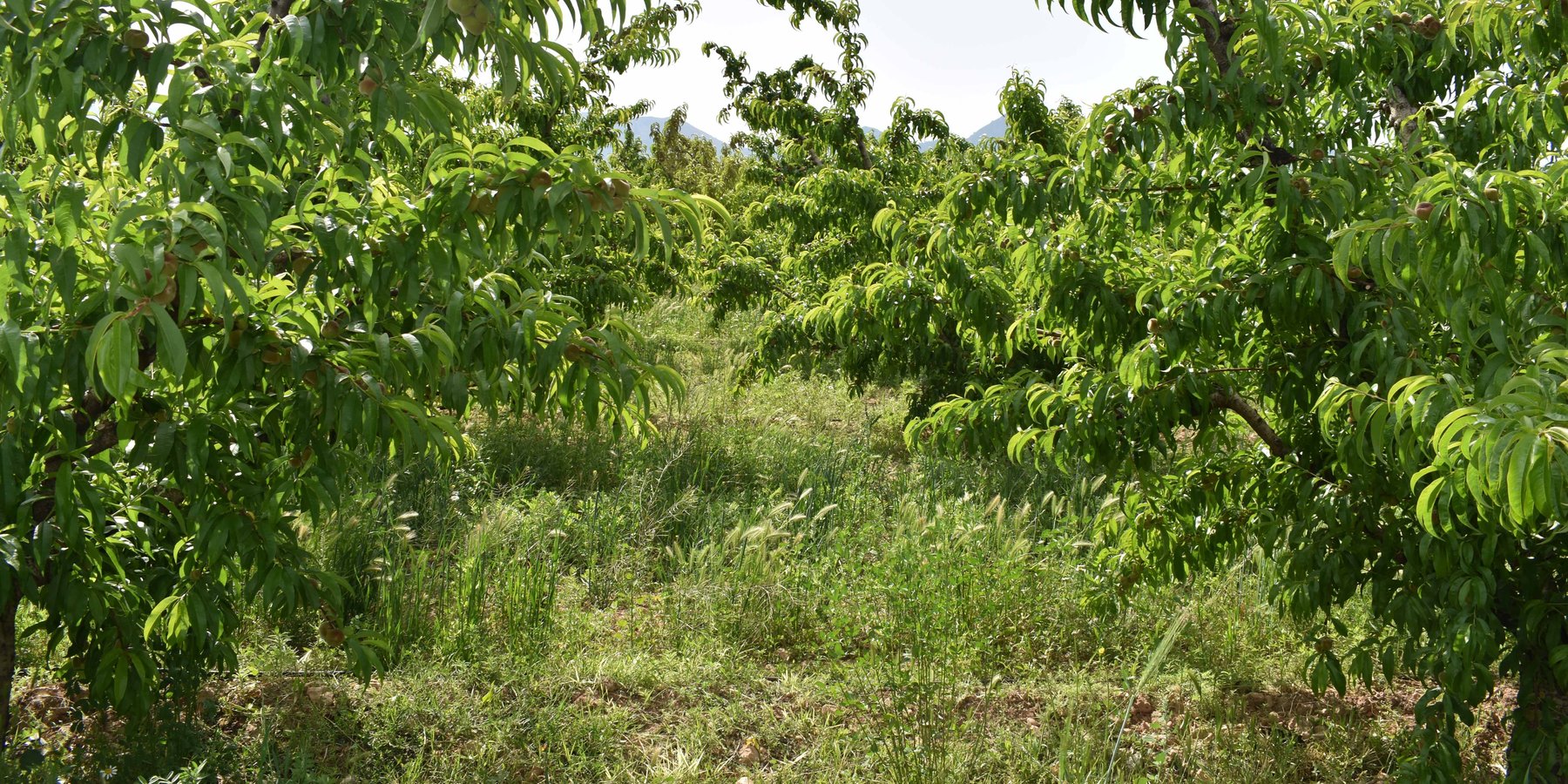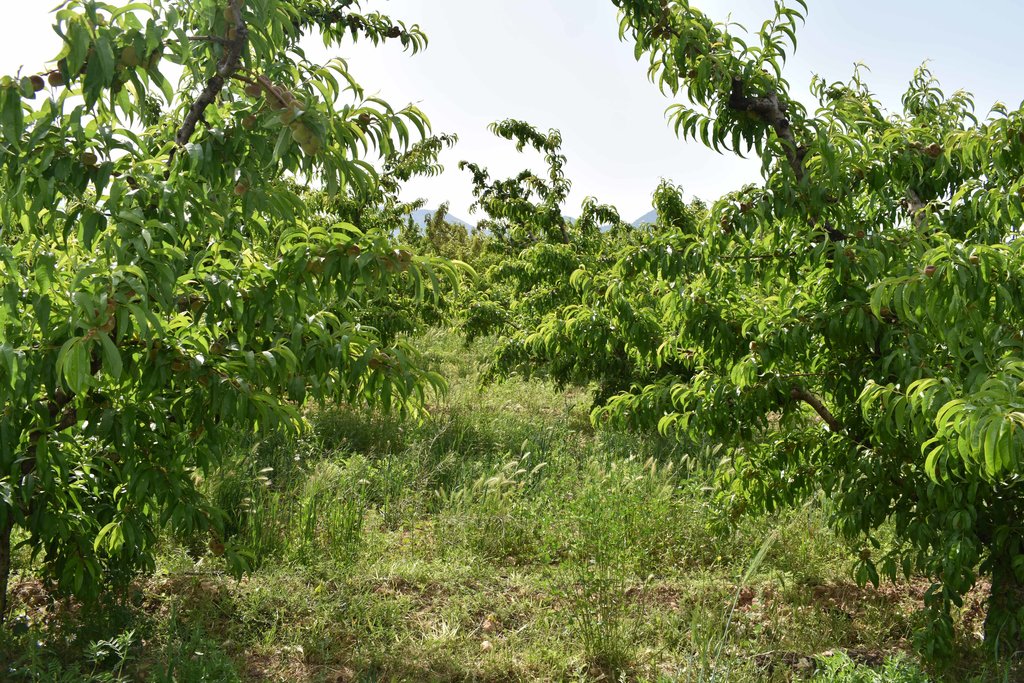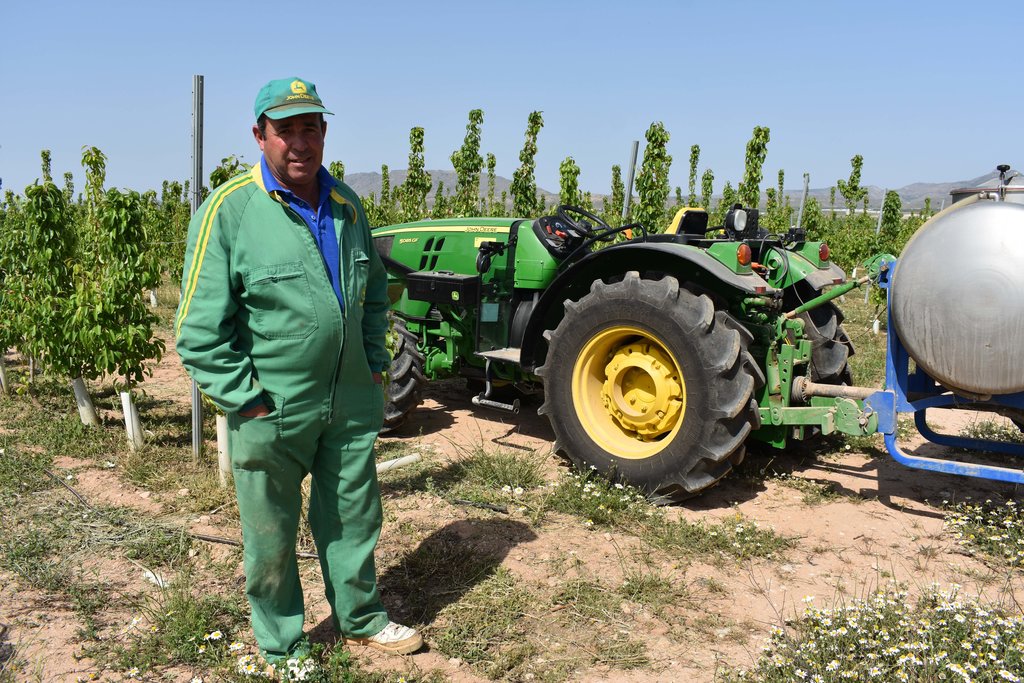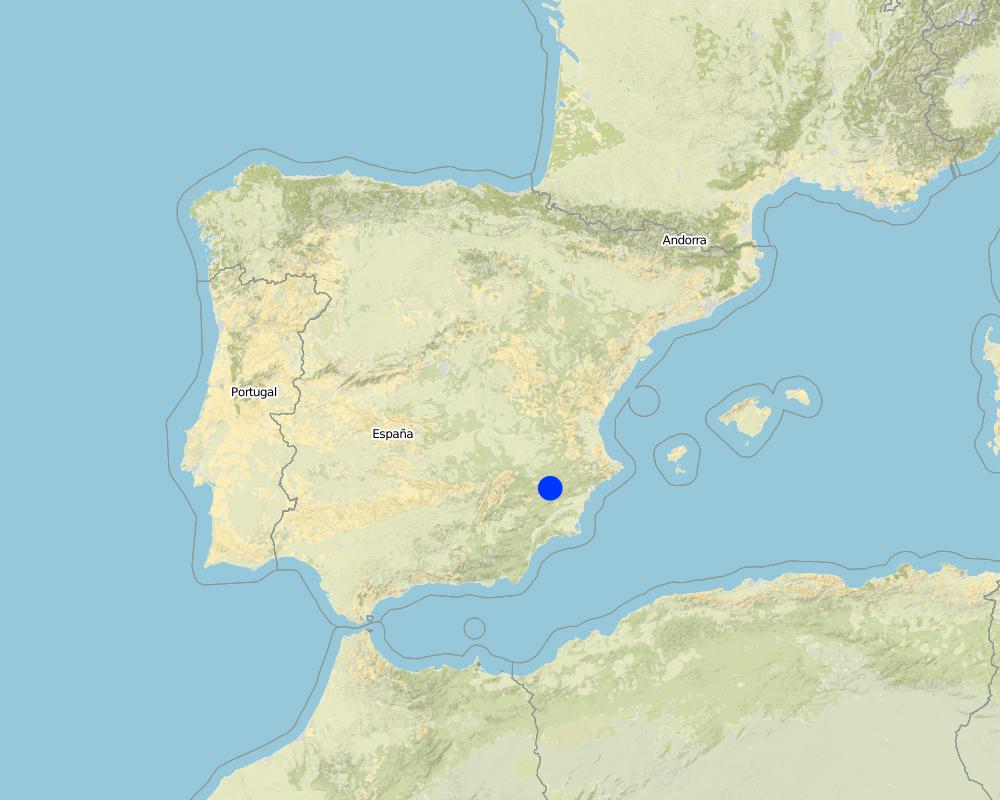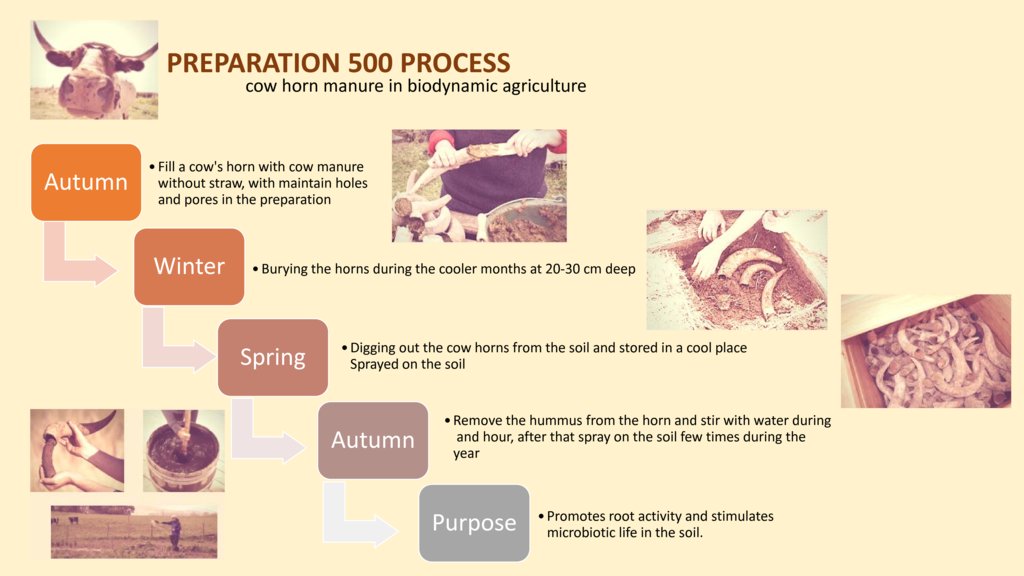Preparation 500 application in agricultural soils under a biodynamic management. [西班牙]
- 创建:
- 更新:
- 编制者: Alicia Morugán-Coronado
- 编辑者: –
- 审查者: Ursula Gaemperli, Gudrun Schwilch, Alexandra Gavilano
Cow horn manure applied in biodynamic agricultural management.
technologies_2690 - 西班牙
查看章节
全部展开 全部收起1. 一般信息
1.2 参与该技术评估和文件编制的资源人员和机构的联系方式
有助于对技术进行记录/评估的项目名称(如相关)
Interactive Soil Quality assessment in Europe and China for Agricultural productivity and Environmental Resilience (EU-iSQAPER)有助于对技术进行记录/评估的机构名称(如相关)
Agrochesmistry and Environment Department, University Miguel Hernandez (UMH) - 西班牙1.3 关于使用通过WOCAT记录的数据的条件
编制者和关键资源人员接受有关使用通过WOCAT记录数据的条件。:
是
1.4 所述技术的可持续性声明
这里所描述的技术在土地退化方面是否存在问题,导致无法被认为是一种可持续的土地管理技术?:
否
1.5 参考关于SLM方法(使用WOCAT记录的SLM方法)的调查问卷
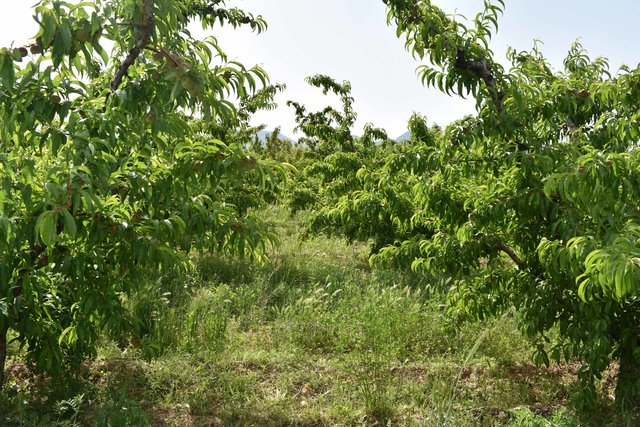
Fruit trees under biodynamic agricultural management in southern … [西班牙]
Biodynamic farming is a method of farming that aims to treat the farm as a living system, based on the application of specific organic preparations which stimulate the natural functions of the farm soils and provide the necessary component towards a self-sustaining agro-ecological farm management.
- 编制者: Alicia Morugán-Coronado
2. SLM技术的说明
2.1 技术简介
技术定义:
This technology is focused in the application of the preparation number 500 based on cow dung filled in cow horns, and buried in the soil pit during the cooler month to improve soil structure, soil nutrition and humus formation
2.2 技术的详细说明
说明:
1. Preparation 500 application in agricultural soils under a biodynamic management is applied in a flat peaches orchard of 40 ha located in Jumilla in southeastern Spain. It is sited in the north east of the Region of Murcia, on the Altiplano area, close to the towns of Cieza and Yecla. This area has an important agricultural activity being the mainly crops the vineyards, Jumilla is a Spanish Denominación de Origen (DO) for wines that extends over
the north of the region of Murcia.
2. This technology is based on the application of the preparation number 500, commonly known as cow horn manure. Preparation 500 is made by filling a cow's horn with cow dung every year, and burying it in the soil during the cooler months (November through February). The horns should be buried open end down so that they will not become water logged if the pit is over watered. When the preparation is ready after 4 months should have turned into dark humus. It should be stored in a cool place and in glazed pots isolated. It is sprayed up to four times a year. The best times are in October and November and then again in February and March. It is stirred for one hour making a vortex. The Horn Manure preparation 500 should be diluted in good-quality rainwater that has been properly stored. The preparation is then stirred vigorously for exactly one hour before spraying. The water should be heated before stirring, ideally to body temperature. Spraying in the field area should be done in the evening, not before 5 pm (4 pm in winter) on a day that is not too windy or too hot, avoiding direct sunlight. A slightly overcast, late afternoon is ideal. Avoid spraying in the rain, or if heavy rains are forecast after spraying. Don't spray if night frost is expected, in order to ensure the correct working of preparation 500.
Preparation 500 is basically fermented cow dung. It is the basis for soil fertility, and the renewal of degraded soils.
3. The main purpose of this technology is focused in to treat the farm as a living system, based on preparations
which mean objective is prepare to soil as self-sustaining agro-ecosystem.
4. This flat tree orchard was under organic farming management before the current technology was applied, the major activity was elaborated the preparation 500 and sprayed out in the orchard. Secondary activities were focused in maintain the preparation during the rest of the year and improve the soil keeping vegetation cover and reducing the tillage.
5. There are several benefits observed after this technology was applied, regarding the soil quality a Strong humus layer was formed and organic matter increased, in general the soil structure improved. Another positive impact was the response against plagues, the establishment of self-sustaining agro-ecosystem increase the biodiversity and the
beneficial species in the orchard.
6. Land user is satisfied with the results of this technology in his orchard because a new market sector opens thanks to changing the orchard to biodynamic farming, the crop quality and the soil properties improved, soil organic matter, soil structure and response against plagues were enhanced. On the other hand, land user dislikes the great amount of money to change the agricultural management to biodynamic farming, the preparations and the external organization certifications are expensive.
2.3 技术照片
2.4 技术视频
注释、简短说明:
The spontaneous plants are cut during may in biodynamic agricultural land in southern Spain
日期:
05/05/2017
位置:
Jumilla
摄影师的名字:
Alicia Morugán Coronado
2.5 已应用该技术的、本评估所涵盖的国家/地区/地点
国家:
西班牙
区域/州/省:
Murcia
有关地点的进一步说明:
Jumilla
具体说明该技术的分布:
- 均匀地分布在一个区域
如果不知道精确的区域,请注明大致覆盖的区域:
- 0.1-1 平方千米
Map
×2.6 实施日期
注明实施年份:
2014
2.7 技术介绍
详细说明该技术是如何引入的:
- 通过土地使用者的创新
3. SLM技术的分类
3.1 该技术的主要目的
- 改良生产
- 减少、预防、恢复土地退化
3.2 应用该技术的当前土地利用类型
同一土地单元内混合使用的土地::
是
具体说明混合土地使用(作物/放牧/树木):
- 农林业

农田
- 多年一作(非木材)
- 乔木与灌木的种植
乔木和灌木种植 - 指定作物:
- 葡萄
- duraznos planos (Prunus persica var. platycarpa), frutas mediterráneas
每年的生长季节数:
- 1
注释:
Organic farming was stablished in 1998. In 2014 the farmer changed the agricultural management to biodynamic practice with the same crop.
3.4 供水
该技术所应用土地的供水:
- 充分灌溉
3.5 该技术所属的SLM组
- 土壤肥力综合管理
3.6 包含该技术的可持续土地管理措施

农艺措施
- A2:有机质/土壤肥力
- A3:土壤表面处理
3.7 该技术强调的主要土地退化类型

化学性土壤退化
- Cn:肥力下降和有机质含量下降(非侵蚀所致)

物理性土壤退化
- Pk:熟化和结壳
- Pu:由于其他活动而导致生物生产功能的丧失

生物性退化
- Bq:数量/生物量减少
- Bs:质量和物种组成/多样性的下降
3.8 防止、减少或恢复土地退化
具体数量名该技术与土地退化有关的目标:
- 防止土地退化
- 减少土地退化
4. 技术规范、实施活动、投入和成本
4.1 该技术的技术图纸
4.2 有关投入和成本计算的一般信息
具体说明成本和投入是如何计算的:
- 每个技术区域
注明尺寸和面积单位:
40
其它/国家货币(具体说明):
euro
如相关,注明美元与当地货币的汇率(例如1美元=79.9巴西雷亚尔):1美元=:
0.944508
注明雇用劳工的每日平均工资成本:
60
4.3 技术建立活动
| 活动 | 时间(季度) | |
|---|---|---|
| 1. | Preparation process | all year |
| 2. | Spread out preparation 500 | november, december, january, may |
| 3. | None | None |
| 4. | None | None |
| 5. | None | None |
注释:
all the costs are for the 40 ha together
4.4 技术建立所需要的费用和投入
| 对投入进行具体说明 | 单位 | 数量 | 单位成本 | 每项投入的总成本 | 土地使用者承担的成本% | |
|---|---|---|---|---|---|---|
| 劳动力 | weed cutting | persona/dia | 2.0 | 60.0 | 120.0 | 100.0 |
| 劳动力 | Filling horns, burying and recovery | persona/dia | 15.0 | 60.0 | 900.0 | 100.0 |
| 劳动力 | Mixing hummus with water and spread out preparation 500 | persona/dia | 5.0 | 60.0 | 300.0 | 100.0 |
| 设备 | electricity | item | 2.0 | 18.0 | 36.0 | 100.0 |
| 设备 | Cow horns to be filled with cow dung | item | 100.0 | 10.0 | 1000.0 | 100.0 |
| 设备 | glazed storing pots for Preparation 500 | item | 3.0 | 50.0 | 150.0 | 100.0 |
| 设备 | tractor with trailer (hire per day) | pieza | 1.0 | 30.0 | 30.0 | 100.0 |
| 设备 | cow dung | item | 5.0 | 60.0 | 300.0 | 100.0 |
| 植物材料 | shovel | item | 1.0 | 15.0 | 15.0 | 100.0 |
| 植物材料 | tank | irem | 1.0 | 10.0 | 10.0 | 100.0 |
| 植物材料 | None | None | 1.0 | 3000.0 | 3000.0 | 100.0 |
| 肥料和杀菌剂 | cow manure needed to produce Preparation 500 | kg | 10.0 | 10.0 | 100.0 | 100.0 |
| 肥料和杀菌剂 | organic amendment | |||||
| 技术建立所需总成本 | 5961.0 | |||||
| 技术建立总成本,美元 | 6311.22 | |||||
注释:
all the costs are for the 40 ha together
4.5 维护/经常性活动
| 活动 | 时间/频率 | |
|---|---|---|
| 1. | weed cutting | October |
| 2. | Biodynamics Preparations | November-December |
| 3. | Biodynamics preparations application | November to May |
| 4. | None | None |
| 5. | None | None |
注释:
all the costs are for the 40 ha together
4.6 维护/经常性活动所需要的费用和投入(每年)
| 对投入进行具体说明 | 单位 | 数量 | 单位成本 | 每项投入的总成本 | 土地使用者承担的成本% | |
|---|---|---|---|---|---|---|
| 劳动力 | Biodynamics preparations application | persona/dia | 15.0 | 60.0 | 900.0 | 100.0 |
| 劳动力 | None | None | 5.0 | 60.0 | 300.0 | 100.0 |
| 劳动力 | None | None | 2.0 | 60.0 | 120.0 | 100.0 |
| 设备 | tractor with trailer (hire per day) | item | 8.0 | 30.0 | 240.0 | 100.0 |
| 肥料和杀菌剂 | preparations | item | 10.0 | 10.0 | 100.0 | 100.0 |
| 肥料和杀菌剂 | manure | item | ||||
| 技术维护所需总成本 | 1660.0 | |||||
| 技术维护总成本,美元 | 1757.53 | |||||
注释:
all the costs are for the 40 ha together
4.7 影响成本的最重要因素
描述影响成本的最决定性因素:
Weather conditions could affect the orchard production if heavy rainfall occur or intensive drought affect to vegetative stress.
5. 自然和人文环境
5.1 气候
年降雨量
- < 250毫米
- 251-500毫米
- 501-750毫米
- 751-1,000毫米
- 1,001-1,500毫米
- 1,501-2,000毫米
- 2,001-3,000毫米
- 3,001-4,000毫米
- > 4,000毫米
指定年平均降雨量(若已知),单位为mm:
369.00
有关降雨的规范/注释:
Lluvias torrenciales concentradas en Septiembre y Octubre
农业气候带
- 半干旱
5.2 地形
平均坡度:
- 水平(0-2%)
- 缓降(3-5%)
- 平缓(6-10%)
- 滚坡(11-15%)
- 崎岖(16-30%)
- 陡峭(31-60%)
- 非常陡峭(>60%)
地形:
- 高原/平原
- 山脊
- 山坡
- 山地斜坡
- 麓坡
- 谷底
垂直分布带:
- 0-100 m a.s.l.
- 101-500 m a.s.l.
- 501-1,000 m a.s.l.
- 1,001-1,500 m a.s.l.
- 1,501-2,000 m a.s.l.
- 2,001-2,500 m a.s.l.
- 2,501-3,000 m a.s.l.
- 3,001-4,000 m a.s.l.
- > 4,000 m a.s.l.
说明该技术是否专门应用于:
- 不相关
5.3 土壤
平均土层深度:
- 非常浅(0-20厘米)
- 浅(21-50厘米)
- 中等深度(51-80厘米)
- 深(81-120厘米)
- 非常深(> 120厘米)
土壤质地(表土):
- 粗粒/轻(砂质)
- 中粒(壤土、粉土)
土壤质地(地表以下> 20厘米):
- 粗粒/轻(砂质)
表土有机质:
- 高(>3%)
如有可能,附上完整的土壤描述或具体说明可用的信息,例如土壤类型、土壤酸碱度、阳离子交换能力、氮、盐度等。:
1157 µS/cm; pH 8; 12% clay, 36% silt; 52% sand; 5.7% organic matter; 5 g/kg Nitrogen; 265 mg(kg available phosphorus.
5.4 水资源可用性和质量
地下水位表:
5-50米
地表水的可用性:
好
水质(未处理):
仅供农业使用(灌溉)
水的盐度有问题吗?:
是
具体说明:
excessive salts content in the irrigation water
该区域正在发生洪水吗?:
否
5.5 生物多样性
物种多样性:
- 中等
栖息地多样性:
- 中等
5.6 应用该技术的土地使用者的特征
定栖或游牧:
- 定栖的
生产系统的市场定位:
- 商业/市场
非农收入:
- 低于全部收入的10%
相对财富水平:
- 平均水平
个人或集体:
- 个人/家庭
机械化水平:
- 机械化/电动
性别:
- 男人
土地使用者的年龄:
- 中年人
5.7 应用该技术的土地使用者使用的平均土地面积
- < 0.5 公顷
- 0.5-1 公顷
- 1-2 公顷
- 2-5公顷
- 5-15公顷
- 15-50公顷
- 50-100公顷
- 100-500公顷
- 500-1,000公顷
- 1,000-10,000公顷
- > 10,000公顷
这被认为是小规模、中规模还是大规模的(参照当地实际情况)?:
- 中等规模的
5.8 土地所有权、土地使用权和水使用权
土地所有权:
- 个人,有命名
土地使用权:
- 个人
用水权:
- 社区(有组织)
5.9 进入服务和基础设施的通道
健康:
- 贫瘠
- 适度的
- 好
教育:
- 贫瘠
- 适度的
- 好
技术援助:
- 贫瘠
- 适度的
- 好
就业(例如非农):
- 贫瘠
- 适度的
- 好
市场:
- 贫瘠
- 适度的
- 好
能源:
- 贫瘠
- 适度的
- 好
道路和交通:
- 贫瘠
- 适度的
- 好
饮用水和卫生设施:
- 贫瘠
- 适度的
- 好
金融服务:
- 贫瘠
- 适度的
- 好
6. 影响和结论性说明
6.1 该技术的现场影响
社会经济效应
生产
作物质量
生产区域
收入和成本
农业投入费用
农业收入
社会文化影响
SLM/土地退化知识
注释/具体说明:
Biodynamic farming reduce soil degradation
生态影响
水循环/径流
水量
土壤
土壤水分
注释/具体说明:
the soil keept the moisture because the organic amendment applied in preparation 500
土壤流失
土壤结壳/密封
土壤压实
养分循环/补给
土壤有机物/地下C
酸度
生物多样性:植被、动物
生物量/地上C
外来入侵物种
有益物种
栖息地多样性
害虫/疾病控制
6.2 该技术的场外影响已经显现
地下水/河流污染
6.3 技术对渐变气候以及与气候相关的极端情况/灾害的暴露和敏感性(土地使用者认为的极端情况/灾害)
渐变气候
渐变气候
| 季节 | 增加或减少 | 该技术是如何应对的? | |
|---|---|---|---|
| 季雨量 | 秋季 | 增加 | 不好 |
气候有关的极端情况(灾害)
气候灾害
| 该技术是如何应对的? | |
|---|---|
| 热浪 | 非常不好 |
| 干旱 | 非常不好 |
生物灾害
| 该技术是如何应对的? | |
|---|---|
| 流行病 | 适度 |
6.4 成本效益分析
技术收益与技术建立成本相比如何(从土地使用者的角度看)?
短期回报:
中性/平衡
长期回报:
积极
技术收益与技术维护成本/经常性成本相比如何(从土地使用者的角度看)?
短期回报:
稍微积极
长期回报:
非常积极
6.5 技术采用
- 单例/实验
在所有采用这项技术的人当中,有多少人是自发的,即未获得任何物质奖励/付款?:
- 91-100%
6.6 适应
最近是否对该技术进行了修改以适应不断变化的条件?:
否
6.7 该技术的优点/长处/机会
| 土地使用者眼中的长处/优势/机会 |
|---|
| Strong humus formation |
| Improvement against plagues |
| Absorption and retention of water is greater |
| 编制者或其他关键资源人员认为的长处/优势/机会 |
|---|
| Increase of organic matter |
| Enhancement of soil structure |
| Increase biodiversity of soil |
6.8 技术的弱点/缺点/风险及其克服方法
| 土地使用者认为的弱点/缺点/风险 | 如何克服它们? |
|---|---|
| Short response time to the weather risks |
| 编制者或其他关键资源人员认为的弱点/缺点/风险 | 如何克服它们? |
|---|---|
| The high dependency on climatological conditions |
7. 参考和链接
7.1 信息的方法/来源
- 实地考察、实地调查
2
- 与土地使用者的访谈
1
- 与SLM专业人员/专家的访谈
2
- 根据报告和其他现有文档进行编译
(现场)数据是什么时候汇编的?:
05/05/2017
7.2 参考可用出版物
标题、作者、年份、ISBN:
no
7.3 链接到网络上的相关信息
标题/说明:
Web page
URL:
http://www.frutasvargas.com/
链接和模块
全部展开 全部收起链接

Fruit trees under biodynamic agricultural management in southern … [西班牙]
Biodynamic farming is a method of farming that aims to treat the farm as a living system, based on the application of specific organic preparations which stimulate the natural functions of the farm soils and provide the necessary component towards a self-sustaining agro-ecological farm management.
- 编制者: Alicia Morugán-Coronado
模块
无模块


